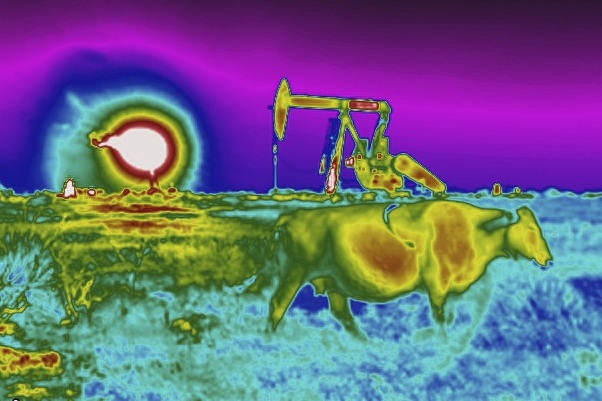Huge quantities of methane, a powerful greenhouse gas, are being emitting by oil and gas operators in the 75,000-square-mile Permian Basin straddling Texas and New Mexico
Harmful gas billowing from Texas and New Mexico comes mostly from smaller leaks, researchers sayBy TAMMY WEBBERThe Associated PressThe Associated Press
The blob on the satellite image is a rainbow of colors. An analyst digitally sharpens it and there, highlighted in red, is the source: a concrete oil pad spewing methane.
In the 75,000-square-mile (194-square-kilometer) Permian Basin straddling Texas and New Mexico, the most productive oil and gas region in the world, huge amounts of the powerful greenhouse gas escape from wells, compressor stations and other equipment.
Most efforts to reduce emissions have focused on so-called “super emitters” like the one in the satellite image, which are relatively easy to find with improving satellite imaging and other aerial sensing.
Now researchers say much smaller sources are collectively responsible for about 72% of methane emissions from oil and gas fields throughout the contiguous U.S. These have often gone undetected.
“It’s really (important to) approach the problem from both ends because the high-emitting super emitters are important, but so are the smaller ones,” said James Williams, a post-doctoral science fellow at the Environmental Defense Fund and lead author on a new study that took a comprehensive look at emissions within the nation’s oil and gas basins.
Addressing methane is important because it accounts for about one third of all greenhouse gas emissions that contribute to climate change.
Tackling methane emissions in the Permian is especially challenging because there are more than 130,000 active well sites owned by everyone from family operators to international conglomerates, experts said. Each site can have multiple oil wells.
“The Permian is in many ways the most complicated basin in the world; it’s incredibly dense there … with big, small and everything in between,” said Steve Hamburg, chief scientist at the Environmental Defense Fund.
What’s more, pipelines, processing and other activities often are owned by different companies — with tens of thousands of points where methane might escape, either through leaks or intentional venting.
An Israeli company that used satellite data and artificial intelligence to look for leaks in Midland County, Texas, the heart of the Permian Basin, found 50 separate plumes emanating from 16 of 30 sites it monitored. Most were bleeding over 4,500 kilograms of harmful gas per hour and five exceeded 10,000, far above the Environmental Protection Agency’s super emitter threshold of 100 kg/hr.
But the biggest surprise, “was seeing a lot of small emissions in this very crowded place … so close to each other, so close to an area where people actually live,” said Omer Shenhar, vice president of product at Momentick, which provides satellite-based monitoring to oil and gas companies.
Methane traps over 80 times more heat close to the Earth than carbon dioxide does, ton for ton. What’s more, concentrations have almost tripled since pre-industrial times.
A powerful new satellite called MethaneSAT that launched this year will be able to detect small emissions over wide areas that other satellites can’t. Researchers will also be able to track methane over time in all the world’s major oil-producing basins.
“We’ve never had that,” said the EDF’s Hamburg, who leads the project.
Although the satellite cannot pinpoint those smaller sources, “you don’t need to” because operators on the ground can find the sources, Hamburg said.
In the U.S., oil and gas companies will be required to routinely look for leaks at new and existing sites, including from wells, production facilities and compressor station under a new EPA rule.
The rule also phases out the practice of routinely burning off excess methane, called flaring, and requires upgrading devices that leak methane.
States have until 2026 to develop a plan to implement that rule for existing sources.
Oil and natural gas companies also would have to pay a federal fee per ton of leaked methane above a certain level under a final rule announced last month by the Biden administration, although the incoming Trump administration could eliminate that.
Methane — the primary component of natural gas — is valuable commercially, yet many operators in the Permian regard it as a nuisance byproduct of oil production and flare it because they haven’t built pipelines to carry it to market, Duren and Hamburg said.
Neither the Permian Basin Petroleum Association nor the U.S. Oil & Gas Association responded to requests for comment.
Riley Duren, CEO of the nonprofit Carbon Mapper, who was not involved in the study, said it’s always important to tackle super emitters because they have such an outsize impact. They are often fleeting but not always. Some continue for weeks, months or years.
Everything adds up.
“I think … what percentage of the total comes from a large number of small sources versus super emitters is less important than what do you do with the information,” said Duren. There are “literally thousands and thousands of pieces of equipment and they can blow a leak at any time.”
___
The Associated Press’ climate and environmental coverage receives financial support from multiple private foundations. AP is solely responsible for all content. Find AP’s standards for working with philanthropies, a list of supporters and funded coverage areas at AP.org.

COMMENTS
Please let us know if you're having issues with commenting.